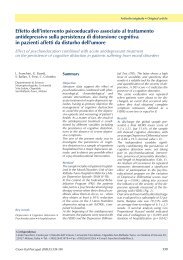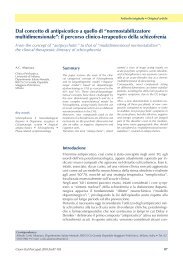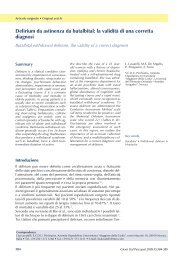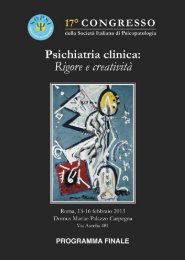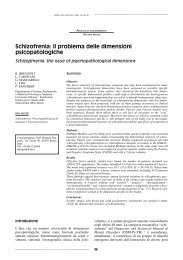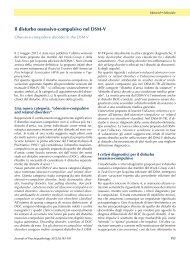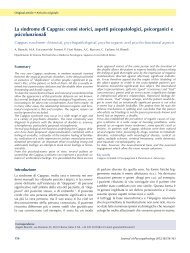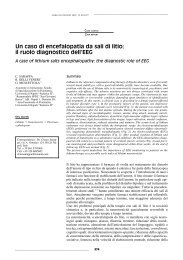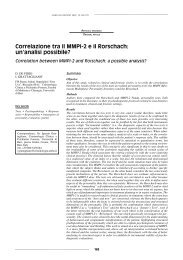XI Congresso della Società Italiana di Psicopatologia Psichiatria ...
XI Congresso della Società Italiana di Psicopatologia Psichiatria ...
XI Congresso della Società Italiana di Psicopatologia Psichiatria ...
You also want an ePaper? Increase the reach of your titles
YUMPU automatically turns print PDFs into web optimized ePapers that Google loves.
creased prefrontal N-acetyl-aspartate on magnetic resonance<br />
spectroscopy. The limbic structures, proposed as biological<br />
substrate of AS, are also crucial in sensorimotor gating, a<br />
process by which excess or non-relevant stimuli are suppressed<br />
or “gated” to allow selective processing of relevant stimuli.<br />
The suppression of the P50 au<strong>di</strong>tory event-related response<br />
is an ideal psychophysiological measure of sensory<br />
gating which has been used extensively in schizophrenia research.<br />
The para<strong>di</strong>gm consists of measuring the amplitude of<br />
the P50 wave to each of two au<strong>di</strong>tory clicks (con<strong>di</strong>tioning<br />
and test). In normal subjects, the second P50 wave is suppressed,<br />
or “gated,” because of the inhibitory effects of the<br />
first click. Prepulse inhibition using the P50 para<strong>di</strong>gm has<br />
been successfully recorded as early as 7 years of age.<br />
In this study we investigated P50 suppression in a group of<br />
children with AS to try and identify whether sensory gating<br />
deficits seen in adults with AS can be identified early in the<br />
natural history of the con<strong>di</strong>tion. We further investigated the<br />
possible correlation with deficits in Theory of Mind tasks, a<br />
reliable measure of social intelligence and of me<strong>di</strong>al prefrontal<br />
cortex activity.<br />
Results have shown a significant impairment in au<strong>di</strong>tory<br />
sensory gating in AS with respect to controls, and a significant<br />
correlation between lack of P50 suppression and increasing<br />
severity in social intelligence deficits. Although the<br />
study design <strong>di</strong>d not enable to assess the specificity of these<br />
fin<strong>di</strong>ngs, results in<strong>di</strong>cate that if confirmed on a larger<br />
sample, P50 suppression might be an objective measure of<br />
severity in the behavioural phenotype.<br />
References<br />
McAlonan GM, Daly E, Kumari V, Critchley HD, van Amelsvoort<br />
T, Suckling J, et al. Brain anatomy and sensorimotor gating in<br />
Asperger’s syndrome. Brain 2002;125:1594-606.<br />
Swerdlow NR, Caine SB, Braff DL, Geyer MA. The neural substrates<br />
of sensorimotor gating of the startle reflex: a review. J<br />
Psychopharmacol 1992;6:176-90.<br />
Baron-Cohen S, Ring HA, Wheelwright S, Bullmore ET, Brammer<br />
MJ, Simmons A, et al. Social intelligence in the normal and autistic<br />
brain: an fMRI study. Eur J Neurosci 1999;11:1891-8.<br />
265. Il suici<strong>di</strong>o come causa evitabile<br />
<strong>di</strong> morte: la mortalità per suici<strong>di</strong>o in Italia<br />
dal 1997 al 2001<br />
D. Pucci1 , M. Paone2 , D. D’Alessandro1 , G.M. Fara1 1 Dipartimento <strong>di</strong> Igiene e Sanità Pubblica “G. Sanarelli”,<br />
Università “La Sapienza” <strong>di</strong> Roma; 2Consulente Mappe<br />
G.I.S.<br />
Introduzione: il suici<strong>di</strong>o è un fenomeno multifattoriale al<br />
quale concorrono <strong>di</strong>versi fattori <strong>di</strong> rischio, sia <strong>di</strong> natura neuropsichiatrica<br />
(depressione, <strong>di</strong>sturbi <strong>di</strong> personalità, abuso <strong>di</strong><br />
sostanze, alcolismo) che <strong>di</strong> natura psicosociale (povertà, <strong>di</strong>soccupazione,<br />
isolamento, mancanza <strong>di</strong> un supporto, eventi<br />
stressanti, invecchiamento).<br />
Obiettivo: valutare la <strong>di</strong>stribuzione dei suici<strong>di</strong> in Italia dal<br />
1997 al 2001 confrontando le varie realtà geografiche.<br />
Metodo: il metodo <strong>della</strong> standar<strong>di</strong>zzazione <strong>di</strong>retta, aggiustata<br />
per età, consente <strong>di</strong> valutare le <strong>di</strong>fferenze <strong>di</strong> mortalità<br />
nelle regioni e nelle province italiane. È stata utilizzata come<br />
popolazione <strong>di</strong> riferimento quella italiana del 2001.<br />
341<br />
POSTER<br />
Risultati: il tasso nazionale me<strong>di</strong>o <strong>di</strong> suici<strong>di</strong> dal 1997 al<br />
2001 è <strong>di</strong> 11,5/100.000 abitanti negli uomini e 3,5/100.000<br />
abitanti nelle donne. Il numero totale <strong>di</strong> suici<strong>di</strong> nel quinquennio<br />
è 20.944 (<strong>di</strong> cui 15.849 uomini e 5.095 donne). Entrambi<br />
i sessi presentano elevati tassi <strong>di</strong> mortalità in Val<br />
d’Aosta (26,8/100.000 nei M, 7,6/100.000 nelle F) e in Sardegna<br />
(M: 20,8); seguono il Trentino Alto A<strong>di</strong>ge, il Friuli<br />
Venezia Giulia, il Piemonte, l’Emilia Romagna, le Marche,<br />
l’Umbria (con tassi compresi tra 13,2 e15,9/100.000 nei M<br />
e tra 4,1 e 4,9/100.000 nelle F). L’incidenza del suici<strong>di</strong>o tende<br />
ad aumentare con l’avanzare dell’età sia negli uomini che<br />
nelle donne. La percentuale <strong>di</strong> suici<strong>di</strong> tra gli uomini oltre i<br />
65 anni è più alta rispetto alle altre fasce d’età. Gli uomini<br />
pre<strong>di</strong>ligono meto<strong>di</strong> <strong>di</strong> soppressione cruenti (impiccagione,<br />
colpo d’arma da fuoco), le donne optano per altri meto<strong>di</strong>:<br />
nell’or<strong>di</strong>ne, la precipitazione, seguita poi dall’impiccagione.<br />
Conclusioni: dalla valutazione dei dati è possibile delineare<br />
l’esistenza <strong>di</strong> alcuni gruppi <strong>di</strong> popolazione che presentano<br />
un rischio suicidario più alto <strong>di</strong> quello cui è esposta la popolazione<br />
generale; nei confronti <strong>di</strong> questi gruppi possono<br />
essere in<strong>di</strong>rizzate delle specifiche strategie <strong>di</strong> prevenzione<br />
primaria e/o secondaria a mezzo <strong>di</strong> interventi specificamente<br />
rivolti alla riduzione del rischio.<br />
Bibliografia<br />
1 Marquet RL, Bartelds AI, Kerkhof AJ, et al. The epidemiology of<br />
suicide and attempted suicide in Dutch General Practice 1983-<br />
2003. BMC Fam Pract 2005;6:45.<br />
2 Saunders K, Hawton K. Suicide prevention and au<strong>di</strong>t. Br J Hosp<br />
Med (Lond) 2005;66:627-30.<br />
3 Goldney RD. Suicide prevention: a pragmatic review of recent<br />
stu<strong>di</strong>es. Crisis 2005;26:128-40.




